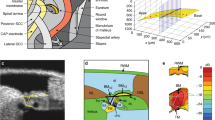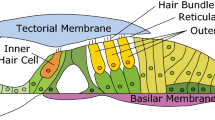Abstract
It is shown that high-Q amplitude-coordinate response curves (sharp tuning) can be obtained in a linear hydromechanical model of the cochlea if the nonuniform transverse stiffness and mass distribution in the basilar membrane partition is taken into account.
Similar content being viewed by others
Literature cited
G. Békésy, Experiments in Hearing, McGraw-Hill, New York (1960), p. 745.
V. M. Babich and S. M. Novoselova, “Vibration of the basilar membrane in the inner ear of mammals,” Zap. Nauchn. Sem. Leningr. Otd. Mat. Inst. Akad. Nauk SSSR,89, 54–62 (1979).
C. R. Steele and L. A. Taber, “Comparison of ‘WKB’ calculations and experimental results for a three-dimensional cochlear model,” J. Acoust. Soc. Am.,65, 1007–1018 (1979).
M. A. Viergever, Mechanics of the Inner Ear, Delft Univ. Press, Delft (1980), p. 165.
S. M. Novoselova, “Tricameral model of the cochlea,” Zap. Nauchn. Sem. Leningr. Otd. Mat. Inst. Akad. Nauk SSSR,148, 133–143 (1985).
S. M. Khanna and D. G. B. Leonard, “Basilar membrane turning in the cat cochlea,” Science,215, 305–306 (1982).
P. M. Sellick, R. Patuzzi, and B. M. Johnstone, “Measurement of basilar membrane motion in the guniea pig using the Mössbauer technique,” J. Acoust. Soc. Am.,72, 131–141 (1982).
E. Boer, “No sharpening? A challenge for cochlear mechanics,” J. Acoust. Soc. Am.,73, No. 2, 567–573 (1983).
M. A. Viergever and R. J. Diependaal, “Simultaneous amplitude and phase match of cochlear model calculations and basilar membrane vibration data,” in: Mechancis of Hearing: Proc. of IUTAM/ICA Symp., Delft Univ. Press, Delft (1983), pp. 53–63.
D. O. Kim, S. T. Neely, C. E. Molnar, and J. W. Matthews, “An active cochlear model with negative damping in the partition: comparison with Rhode's ante- and post-mortem observations,” in: Psychophysical, Psychological and Behavioural Studies in Hearing, Delft Univ. Press, Delft (1980), pp. 7–14.
S. T. Neely, “Mathematical modeling of cochlear mechanics,” J. Acoust. Soc. Am.,78, No. 1, 345–352 (1985).
D. J. Lim, “Cochlear anatomy related to cochlear micromechanics: a review,” J. Acoust. Soc. AM.,67, No. 5, 1686–1695 (1980).
Additional information
Translated from Zapiski Nauchnykh Seminarov Leningradskogo Otdeleniya Matematicheskogo Instituta im. V. A. Steklova AN SSSR, Vol. 156, pp. 158–167, 1986.
The author gratefully acknowledge Prof. V. M. Babich for his steadfast and generous interest in the work and for valuable discussions.
Rights and permissions
About this article
Cite this article
Novoselova, S.M. Vibrations of a transversely nonuniform basilar membrane in the mammalian cochlea. J Math Sci 50, 1780–1785 (1990). https://doi.org/10.1007/BF01097110
Issue Date:
DOI: https://doi.org/10.1007/BF01097110




